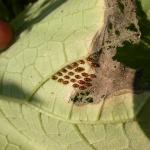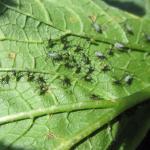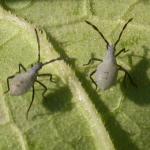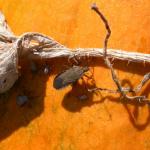Squash Bug
Adult squash bugs (Anasa tristis) are flat, gray-brown insects which feed on a variety of cucurbits. Their favorite host plants are summer squash and zucchini, especially when these plants are large and provide ample food, shelter, and egg-laying sites. Squash bugs can cause both leaf and fruit injury if numbers are high.
Life Cycle & Identification:

 Squash bugs are a type of true bug, a group that also includes other pests like the native brown stink bug and brown marmorated stink bug, as well as beneficial insects like the spined soldier bug. Sheltered and protected areas such as field borders, woods edges, brush or wood piles, and crop residues in the field provide a home for unmated adults through the winter. Adults are 0.5-0.75 inches long, flattened, and grayish-brown, and can be differentiated from stink bugs and spined soldier bugs by their more elongated body shape and rounded shoulders. The edge of the abdomen is marked with alternating gold and brown patches. Adults frequently take shelter beneath debris in the field at night, and it’s common to see many bugs congregated beneath a squash fruit in the field.
Squash bugs are a type of true bug, a group that also includes other pests like the native brown stink bug and brown marmorated stink bug, as well as beneficial insects like the spined soldier bug. Sheltered and protected areas such as field borders, woods edges, brush or wood piles, and crop residues in the field provide a home for unmated adults through the winter. Adults are 0.5-0.75 inches long, flattened, and grayish-brown, and can be differentiated from stink bugs and spined soldier bugs by their more elongated body shape and rounded shoulders. The edge of the abdomen is marked with alternating gold and brown patches. Adults frequently take shelter beneath debris in the field at night, and it’s common to see many bugs congregated beneath a squash fruit in the field.
Adults are long-lived and lay eggs over several weeks. A single female can lay up to 250 yellow- to bronze-colored eggs, usually in an orderly cluster in the junction of leaf veins on the underside of leaves, which hatch in 7-10 days in summer conditions. Nymphs are wingless and usually found in groups. They are light green when small, with a dark-colored head and legs, but become darker gray and more solitary as they grow and molt through 5 nymphal stages. There is one generation per year in the Northeast, and the complete life cycle requires 6-8 weeks.
Crop Injury:
The most susceptible and attractive crops are yellow summer squash, zucchini, and pumpkin (Cucurbita pepo) as well as C. maxima crops (e.g. Hubbard squash). Watermelon, cucumber, muskmelon, and butternut resist damage and provide poor food quality for adults and nymphs. Resistant varieties also include sweet cheese pumpkins (C. moshata) and royal acorn squash (C. pepo).
Both adults and nymphs feed by sucking sap from plant tissue using their beak-like mouthparts. This interrupts xylem transport and causes wilting in leaves, stems, and vines that are beyond the feeding site. The injury may appear as light-colored areas that later turn brown and die, symptoms that resemble bacterial wilt. Places on the leaves where the bugs feed develop small, yellow specks that eventually turn brown due to a toxin released by the bug while it feeds. High densities and intensive feeding cause foliage to wilt, turn black and die in a condition known as “Anasa wilt”. Squash bugs also feed on the fruit, causing scarring that can make the fruit unmarketable. In late summer and fall, large nymphs and new adults can damage the fruit of fall vine crops.
Squash bugs may also vector the bacterium Serratia marcescens, which causes the disease yellow vine decline. This disease is reported intermittently in New England; it is not thought to be widespread, but it was found in MA in 2003 and was again confirmed from one site in CT in 2020. The bacterium is introduced into a cucurbit plant by squash bug mouthparts and enters the plant’s phloem sap. Symptoms of yellow vine decline include a general yellowing of the entire vine within a two- to three-day period. Infected plants usually collapse completely approximately 10 to 14 days before the fruit matures. Plants infested with squash vine borer can display similar symptoms—leaf yellowing, wilt, lack of vigor—but will have an entry hole in the stem where the borer entered, usually accompanied by lots of sawdust-like frass.
Monitoring & Thresholds:
Scout plants from seedling to vining/flowering stage to detect adults as well as eggs and nymphs. Search upper and lower leaf surfaces and soil cracks around the plant. The population level that will be damaging to the crop will vary with the crop and its stage of growth. Controls are warranted if you see more than one egg mass per plant, especially early in the season. In watermelon, a threshold of 1 adult per plant was determined to be effective (see below).
Cultural Controls & Prevention:
- Rotate cucurbit crops between fields as far apart as possible.
- Place row covers over the young crop to prevent adult access until blooming, when covers must be removed.
- Avoid mulching with hay or straw and low- or no-till systems. We have observed higher squash bug numbers in fields in these systems; squash bugs may prefer the shelter provided by high cover crop residues.
- Reduce overwintering sites by keeping headlands and field borders mowed and free of trash.
- Remove crop residues and/or till field immediately after harvest to kill adults before they move to field edges seeking shelter.
- Trap cropping: Blue Hubbard squash can be an effective perimeter trap crop as it is preferred by both squash bug and cucumber beetles over vine crops. In Texas, many growers have successfully used early-planted straightneck summer squash ('Lemon Drop' or 'Hyrific') as a trap crop in the border rows of their watermelon fields to attract and control squash bugs to manage CYVD. A study conducted by Oklahoma State University found that squash bugs prefer to lay eggs on yellow straightneck and crookneck (Bonjour et al. 1990) and these cucurbits can be used effectively as a trap crop planted earlier in the season along field edges where adults will be attracted first while the main crop gets planted later and establishes. The trap crop must receive an insecticide application or be mechanically destroyed before eggs hatch.
- Trap bugs in small plantings by placing some boards on the ground to attract adults seeking a protected hiding place and checking underneath them in the morning or evening. Squash bugs found underneath can be destroyed mechanically or with an insecticide spray.
Biological Controls:
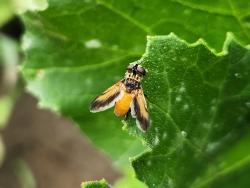 The swift feather-legged fly (Trichopoda pennipes) is a brightly-colored parasitoid fly which lays small white eggs on adults and nymphs of squash bugs and stink bugs. These eggs hatch into larvae which burrow into the bugs, eventually killing the host. Unfortunately, these fly eggs do not hatch and kill the squash bug in time to prevent reproduction and feeding damage. However, parasitization can decrease the number of squash bugs which overwinter and reproduce the following year, resulting in lower pest pressure in the long term. The adult fly feeds on nectar from flowers such as Queen Anne's lace, meadowsweet, asters, and goldenrods.
The swift feather-legged fly (Trichopoda pennipes) is a brightly-colored parasitoid fly which lays small white eggs on adults and nymphs of squash bugs and stink bugs. These eggs hatch into larvae which burrow into the bugs, eventually killing the host. Unfortunately, these fly eggs do not hatch and kill the squash bug in time to prevent reproduction and feeding damage. However, parasitization can decrease the number of squash bugs which overwinter and reproduce the following year, resulting in lower pest pressure in the long term. The adult fly feeds on nectar from flowers such as Queen Anne's lace, meadowsweet, asters, and goldenrods.
Other natural enemies include several species of wasps in the families Encyrtidae and Scelionidae which parasitize squash bug eggs.
Chemical Controls & Pesticides:
There are two key windows for controlling squash bugs:
- Target adults on young plants (before flowering or vining). An insecticide application made when adults are colonizing plants in June will prevent subsequent egg and larval populations. Coverage is easier at this time, and broad-spectrum pyrethroids (e.g. bifenthrin, lambda-cyhalothrin, permethrin) or carbaryl, which are reported to be effective on adults at this stage, can be used without risk to bees on the crop. OMRI-approved pyrethrin products are available e.g. PyGanic). The threshold for targeting adults has been determined for watermelon crops at an average of 1 adult per plant (Dogramaci et al. 2006), but in more susceptible crops such as summer squash and zucchini, it might be appropriate to use a lower threshold (e.g. 1 adult per 2 or more plants). Aim for coverage of underside of leaves and stems where bugs hide. Systemic furrow, drip, or seed treatments and sprays for cucumber beetle at the seedling stage may also control colonizing squash bug adults.
- Target smaller nymphs on flowering plants. Scout for egg masses and note the first emergence of nymphs. The threshold is reached at an average of 1 egg mass per plant and when the first nymphs are seen. Good coverage of undersides of leaves is needed. For newly laid eggs and nymphs, consider a foliar application of acetamiprid (Assail 30 SG) which has moderate toxicity to bees (lower than other neonicotinoids). Adults and larger nymphs are more difficult to control, partly because they hide in the lower canopy and near the soil. An organic option for nymphs is a mixture of pyrethrin (a contact toxin) and azadiractin (an insect growth regulator, derived from neem). This would be gentler on bees than a high rate of pyrethrin alone and would include two modes of action. Insect growth regulators work to disrupt the molting process, so they are useful only on immature stages. Treat late in the day when the flowers are closed to reduce risk to bees.
Take note of re-entry and pre-harvest intervals of materials used on summer squash and zucchini that are being harvested frequently.
For more information on rates and products for squash bug control, check the New England Vegetable Management Guide. This also has current information on production methods (including varieties, spacing, seeding, and fertility), weed, and disease, management of squash and other Cucurbit crops. See also the IPM Guide on Diseases of Cucurbit Crops.
Crops that are affected by this insect:
The Center for Agriculture, Food and the Environment and UMass Extension are equal opportunity providers and employers, United States Department of Agriculture cooperating. Contact your local Extension office for information on disability accommodations. Contact the State Center Director’s Office if you have concerns related to discrimination, 413-545-4800 or see ag.umass.edu/civil-rights-information.
